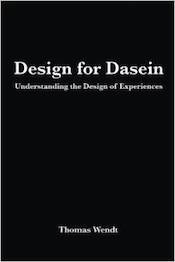“To apply a phenomenological approach to design is to focus at the dual question of how design, as a medium of meaning formation, both relates to and possibly changes the constituents of experience.”—Mads Nygaard Folkmann
My interest in phenomenology dates back about a decade. I was introduced to the field as an undergraduate and thought it was an interesting way of thinking about big, lofty questions like “what does it mean to be?” It wasn’t until a few years later, after becoming involved experience design that I returned to phenomenology as a way of understanding the work I do. Aside from the big, lofty questions, we can read phenomenology as the study of human experience. So if we interpret experience design literally as the design of experiences, then we can use phenomenology to inform the intellectual background necessary for the evolution of the discipline.
I wrote Design for Dasein: Understanding the Design of Experiences to address this need. Academics and practitioners have recognized the relationship between phenomenology and design, but references within existing literature exist mostly as sporadic mentions and rarely entire articles. I wanted to write a book that will spark some interest in both academic and practitioner communities, hopefully inspiring deeper collaboration. Below are some key points from the book I believe are fundamental to the evolution of experience design.
Emphasis on Praxis and Context
The word “Dasein” in the title of the book refers to the work of German philosopher Martin Heidegger, who argued that human existence is not a detached, speculative phenomenon but rather a grounded experience wrapped up in interactions with the environment. Dasein literally translated means “here/there-being,” or more commonly, “being-there” or “being-in-the-world.” It emphasizes that Being is intimately connected to its context, and the idea that we cannot conceive of Being as a detached form of existence. We are not entities simply floating around in space; we are intentional, future-facing beings whose action is mediated by the objects that surround us. Thus, we cannot think about our existence as divorced from experience.
Given the importance of situated being, phenomenology also emphasizes the role or praxis, a type of action based on process rather than product. It is not that the individual interacts with his or her world simply to achieve goal. S/he also derives meaning from the action as an enactment of worldly understanding. In other words, an action such as scanning one’s Instagram feed allows for goal-oriented action—seeing friends’ photos, killing time, avoiding eye contact with someone. Further, it allows for praxical action such as the enjoyment of seeing visual stimuli. In the former case, the end goal lies beyond the action; in the latter, the value of the action is embedded within the action itself.
Within the designer’s world, the process of sketching is the quintessential example of a praxical activity. Sketching, at least with an experience design context, very rarely results in anything meaningful beyond its process as it contributes to the designer’s understanding. What is sketched on paper is usually of much less important than the process of sketching, in which the designer is able to think in the physical world; s/he takes what is usually viewed as ‘internal’ and puts it on paper, specifically to think through it in more detail. The new perspectives that emerge from the sketching process are much more valuable that the sketch itself. In this way, praxis is a type of practice that incorporates some of the more intangible components of theory.
Objects, Things, and Meaning
After Heidegger, a new breed of phenomenological thinkers began to revise much of the existing thought, especially around the role of technology. What eventually was named post-phenomenology focuses on the role of individual objects and networks of interaction to articulate a holistic theory of human engagement with the world. Post-phenomenology evolved much of Heidegger’s later thinking on technology by adding two key concepts: mediation and multistability.
We cannot think about our existence as divorced from experience
If I asked a sample of this article’s readers about the purpose of user testing, I would likely get a range of answers including “to identify usability issues,” “to test ideas,” and “to make the product easier to use.” All these answers are valid in their own way and point to the concept of multistability, put forth by post-phenomenological thinker, Don Ihde.
Multistability states that any piece of technology literally has multiple stabilities, or many means of finding stabile meaning. In other words, technology means different things and has different purposes in different situations. A simple example of a water bottle has the professed purpose of enabling users to carry water with them, effectively drink out of the bottle without spilling, and possibly to display their concern for the purity of their water. All of these are intended purposes. However, if one picks up a water bottle and throws it at someone else, it ceases to be a bottle and becomes a weapon. This is the effect of multistability. In the book I argue that user testing and rapid prototyping are ways that experience designers explore and play with these multiple stabilities. They probe systems of interaction—a deep praxis engagement—to identify points of variability attempt to optimize for a desired result.
Related to multistability is the notion of mediation, articulated by Peter-Paul Verbeek as a way of explaining how technology actively mediates the relationship between self and world. Throughout most of philosophy and cognitive science, we have assumed that humans are somehow separate from their environment: there is “me,” and then there is all this other “stuff out there.” This dualist point of view assumes that humans act with intention on the world.
For example, a human might plan a walk in the park. A dualist view might assert that one accesses a mental map of the park in one’s head, plans a route, attaches the leash to the dog’s collar, and proceeds on the walk. A non-dualist point of view might say that the individual simply begins walking and adapts to ever-changing needs in the environment, as opposed to mental planning and execution. If a tree branch falls across the path, one does not simply proceed as planned; rather, they adapt and step over or around the branch. Further, a mediated view would point out that the tool used in the situation, namely the dog’s leash, is not simply an object to achieve a goal (to keep the dog close). Instead, the leash actively mediates the situation and our interpretation of it. Swap the leash with any other object—a shopping cart, a baseball bat—and the situation is completely different. The leash mediates the human; it designates him or her as a dog walker, and not a grocery shopper or baseball player.
The theory of mediation, then, holds that the things we design are not neutral material in the world—they are active sources of meaning generation and understanding, constantly shaping the identities, for better or worse, of those who use them.
Implications for Design Thinking
These two examples of multistability and mediation point to the inherent fickleness of design. Pushed to its logical extreme, we can read multistability as being pseudo-nihilistic: if technology is completely context-dependent, then any time a designed object is used outside an intended context, it will have completely different results. And since technological objects mediate the human-world relationship, how can designers reliably ensure that their intention comes across?
I argue that theories of design that rely on intention as the primary driver of progress are misguided. While intention is important, forces such as multistability show that technology use is emergent, despite designers’ best efforts to control it. However, attempting to skirt the role of intention is not advisable either. Certainly, intention plays a role in the design process. The synthesis lies somewhere in between: design is not simply an instantiation of designer intent, but it is also not a pure build-test-refine practice.
To further complicate the positivist view of design as a purely intentional process, I also propose that much of experience design practice is based on a paradox. Designers, mostly under the influence of clients, like to think that they move linearly from problem to solution—that we spend time doing research to understand a problem space and then move to ideation in order to solve that problem. What I call the problem-solution paradox states that we cannot design solutions until we understand a problem space (this is the linear view), but it is also true that we cannot understand problems before conceiving potential solutions.
There is a reciprocal relationship between problems and solutions, with a constant movement back and forth that facilitates understanding. This view is based on the hermeneutic circle, or the idea that we cannot understand the whole without understanding the parts, and we cannot understand the parts without also understanding the whole. The process of interpretation, or design in this case, is a constant movement between these two modes.
Implications for Experience Designers
Everyone designs, but not everyone is a designer. We all shape our environment and contextual situation in some way. In a sense, this is the essence of Dasein: the human condition of being-in-the-world necessitates an active engagement with the world, or a need to exploit natural affordances and design our own solutions when necessary. But being a designer, as Heidegger tells us in his later work, involves a deeper engagement with the materials and non-materials of design.
Heidegger gives the example of a craftsperson who takes care to work with the grain of the wood, as opposed to hacking away without regard for the natural state of materials. S/he shapes the physical material of the object but also the immaterial qualities that result from the object coming into existence. In his famous example, Heidegger asserts that the designer of a jug creates the walls and bottom of the jug, but more importantly s/he creates the void, the empty space in the middle that gathers wine for a special occasion. This void is the realm of experience. The physical qualities of what we design are certainly important, but the intangible experiences—while much more difficult to clearly identify—are what connect the poles of interaction and experience.
Design for Dasein argues that this is the special place for experience designers. Being an experience designer calls for a need to orient oneself toward the (im)materials at hand, and to take great care when crafting the intangible aspects of a designed system. There is a certain responsibility the designer takes for the designed system, with the caveat that multistability will always strip some agency from the designer’s hand.
In the end, experience designers, if we take our field seriously, are in a unique position to examine the “post-design” situation. The design process is interesting, but the work of experience design shapes the world only after the “thing” is created. Understanding experience is crucial for the discipline to grow, and I think phenomenology is the best place to start this process of understanding.
To read more about the intersection of phenomenology, experience design, and design thinking, pick up a copy of Design for Dasein. (Illustration of water bottle courtesy Shutterstock.)








